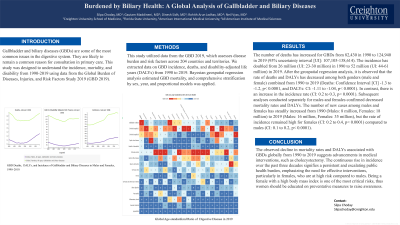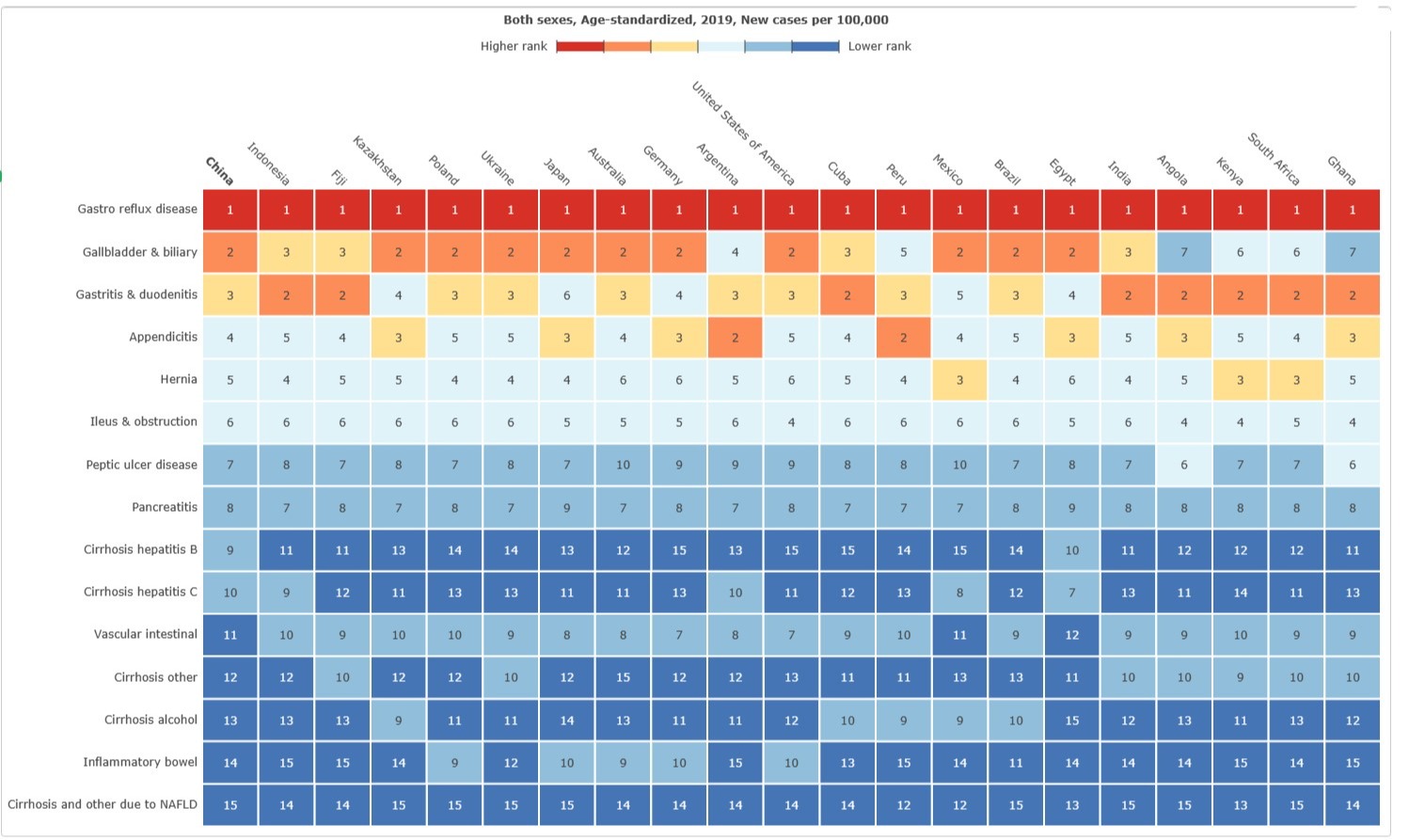Tuesday Poster Session
Category: Biliary/Pancreas
P2871 - Burdened by Biliary Health: A Global Analysis of Gallbladder and Biliary Diseases
Tuesday, October 24, 2023
10:30 AM - 4:00 PM PT
Location: Exhibit Hall

Has Audio

Silpa Choday, MD
Creighton University
Phoenix, Arizona
Presenting Author(s)
Silpa Choday, MD1, Gautam Maddineni, MD2, Dinesh Sidh, MD3, Rohith Arun Jadhav, MD4, Neil Vyas, MD1
1Creighton University, Phoenix, AZ; 2Florida State University, Cape Coral, FL; 3American International Medical University, Gros Islet, Gros-Islet, Saint Lucia; 4All American Institute of Medical Science, Black River, Saint Elizabeth, Jamaica
Introduction: Gallbladder and biliary diseases (GBDs) are some of the most common issues in the digestive system. They are likely to remain a common reason for consultation in primary care. This study was designed to understand the incidence, mortality, and disability from 1990-2019 using data from the Global Burden of Diseases, Injuries, and Risk Factors Study 2019 (GBD 2019).
Methods: This study utilized data from the GBD 2019, which assesses disease burden and risk factors across 204 countries and territories. We extracted data on GBD incidence, deaths, and disability-adjusted life years (DALYs) from 1990 to 2019. Bayesian geospatial regression analysis estimated GBD mortality, and comprehensive stratification by sex, year, and proportional models was applied.
Results: The number of deaths has increased for GBDs from 82,430 in 1990 to 124,940 in 2019 (95% uncertainty interval [UI]: 107,105-138,614). The incidence has doubled from 26 million (UI: 23-30 million) in 1990 to 52 million (UI: 44-61 million) in 2019. After the geospatial regression analysis, it is observed that the rate of deaths and DALYs has decreased among both genders (male and female) combined from 1990 to 2019 (Deaths: Confidence Interval [CI] -1.3 to -1.2, p< 0.0001, and DALYs: CI: -1.11 to -1.04, p< 0.0001). In contrast, there is an increase in the incidence rate (CI: 0.2 to 0.3, p< 0.0001). Subsequent analyses conducted separately for males and females confirmed decreased mortality rates and DALYs. The number of new cases among males and females has steadily increased from 1990 (Males: 8 million, Females: 18 million) to 2019 (Males: 16 million, Females: 35 million), but the rate of incidence remained high for females (CI: 0.2 to 0.4, p< 0.0001) compared to males (CI: 0.1 to 0.2, p< 0.0001).
Discussion: The observed decline in mortality rates and DALYs associated with GBDs globally from 1990 to 2019 suggests advancements in medical interventions, such as cholecystectomy. The continuous rise in incidence over the past three decades signifies a persistent and escalating public health burden, emphasizing the need for effective interventions, particularly in females, who are at high risk compared to males. Being a female with a high body mass index is one of the most critical risks, thus women should be educated on preventative measures to raise awareness.

Disclosures:
Silpa Choday, MD1, Gautam Maddineni, MD2, Dinesh Sidh, MD3, Rohith Arun Jadhav, MD4, Neil Vyas, MD1. P2871 - Burdened by Biliary Health: A Global Analysis of Gallbladder and Biliary Diseases, ACG 2023 Annual Scientific Meeting Abstracts. Vancouver, BC, Canada: American College of Gastroenterology.
1Creighton University, Phoenix, AZ; 2Florida State University, Cape Coral, FL; 3American International Medical University, Gros Islet, Gros-Islet, Saint Lucia; 4All American Institute of Medical Science, Black River, Saint Elizabeth, Jamaica
Introduction: Gallbladder and biliary diseases (GBDs) are some of the most common issues in the digestive system. They are likely to remain a common reason for consultation in primary care. This study was designed to understand the incidence, mortality, and disability from 1990-2019 using data from the Global Burden of Diseases, Injuries, and Risk Factors Study 2019 (GBD 2019).
Methods: This study utilized data from the GBD 2019, which assesses disease burden and risk factors across 204 countries and territories. We extracted data on GBD incidence, deaths, and disability-adjusted life years (DALYs) from 1990 to 2019. Bayesian geospatial regression analysis estimated GBD mortality, and comprehensive stratification by sex, year, and proportional models was applied.
Results: The number of deaths has increased for GBDs from 82,430 in 1990 to 124,940 in 2019 (95% uncertainty interval [UI]: 107,105-138,614). The incidence has doubled from 26 million (UI: 23-30 million) in 1990 to 52 million (UI: 44-61 million) in 2019. After the geospatial regression analysis, it is observed that the rate of deaths and DALYs has decreased among both genders (male and female) combined from 1990 to 2019 (Deaths: Confidence Interval [CI] -1.3 to -1.2, p< 0.0001, and DALYs: CI: -1.11 to -1.04, p< 0.0001). In contrast, there is an increase in the incidence rate (CI: 0.2 to 0.3, p< 0.0001). Subsequent analyses conducted separately for males and females confirmed decreased mortality rates and DALYs. The number of new cases among males and females has steadily increased from 1990 (Males: 8 million, Females: 18 million) to 2019 (Males: 16 million, Females: 35 million), but the rate of incidence remained high for females (CI: 0.2 to 0.4, p< 0.0001) compared to males (CI: 0.1 to 0.2, p< 0.0001).
Discussion: The observed decline in mortality rates and DALYs associated with GBDs globally from 1990 to 2019 suggests advancements in medical interventions, such as cholecystectomy. The continuous rise in incidence over the past three decades signifies a persistent and escalating public health burden, emphasizing the need for effective interventions, particularly in females, who are at high risk compared to males. Being a female with a high body mass index is one of the most critical risks, thus women should be educated on preventative measures to raise awareness.

Figure: Global Age-standardized Ratio of Incidence by Digestive Disease during 2019
Disclosures:
Silpa Choday indicated no relevant financial relationships.
Gautam Maddineni indicated no relevant financial relationships.
Dinesh Sidh indicated no relevant financial relationships.
Rohith Arun Jadhav indicated no relevant financial relationships.
Neil Vyas indicated no relevant financial relationships.
Silpa Choday, MD1, Gautam Maddineni, MD2, Dinesh Sidh, MD3, Rohith Arun Jadhav, MD4, Neil Vyas, MD1. P2871 - Burdened by Biliary Health: A Global Analysis of Gallbladder and Biliary Diseases, ACG 2023 Annual Scientific Meeting Abstracts. Vancouver, BC, Canada: American College of Gastroenterology.
